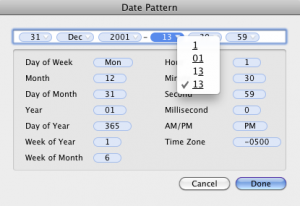Now that summer is well underway, many of us are deeply ensconced in archival research. Some of us, particularly the newly-ABD, are looking at our digital cameras and carts full of Hollinger boxes and wondering how to make sense of it all.
I’ve written before about hacking better tools for the short research trip and taming the all-digital research collection, but here’s a more specific tip:
When you’re shooting reference-quality photos, think about your file names like accession numbers. When you take notes, you’re going to want to refer to individual images, and it’s easier to take notes from photos if you know that every image you ever shoot has a unique file name.
On the Mac, I use a simple file renaming tool, Hazel, to make this easier. Hazel watches whatever directories you tell it to, then executes a set of rules on the files it finds. It’s free for a 14-day trial and US$21.95 to register. Here’s what it looks like (click on the image to enlarge):
So I have a folder called incoming images, and I can tell Hazel to pick up all JPG files that begin in DSCN— which is how my camera names files— and rename them according to a pattern I choose. Here’s the rule-setting dialog:
For archival reference images, it’s important that the pattern be sortable and that it be based on the file creation time of the image as it comes from your camera. That way, when you sort the files by name, you see them in the order that you shot them.
When I started doing this several years ago, I wanted something human-readable, so I chose to use a naming convention that contained a written-out month. By this rule, DSCN0316.JPG became 08Jun2008-113648 DSCN0316.JPG— an image that I shot on June 8, 2008, at 11:36:48. That way, however I moved the file (to put it into folders by collection), it would retain its sortability.
Note that the numbers are all padded with leading zeros; this is what makes the sorting work properly. To make sure this happens in Hazel, you’ll need to edit the date pattern:

Then, for every element of the date where you’re using a number, set it so that all digits of the number will be displayed, like this:

If I were setting up a naming convention again, I’d do it differently, more like museums and archives do their accession numbers: year.month.day.serialnumber, where serialnumber starts at 00001 and goes up for each photo I shoot that day. Unfortunately, this is a kind of renaming that Hazel doesn’t support well, and it requires slightly more complex scripting. In the meantime, this works fine.
I’ve posted the Hazel ruleset I use to my diy-archives-tools package, which is hosted at GitHub. (GitHub is a social version-control site; it lets me share revisions for software that I’m working on. For more on version control systems like Git and how to use them, read Julie Meloni’s A Gentle Introduction to Version Control.)


Michael
on Jan 2nd, 2011
@ 7:43 am:
This is the best real-world example of how to use Hazel I have found on-line, thanks for putting in the effort to describe it for all of us.